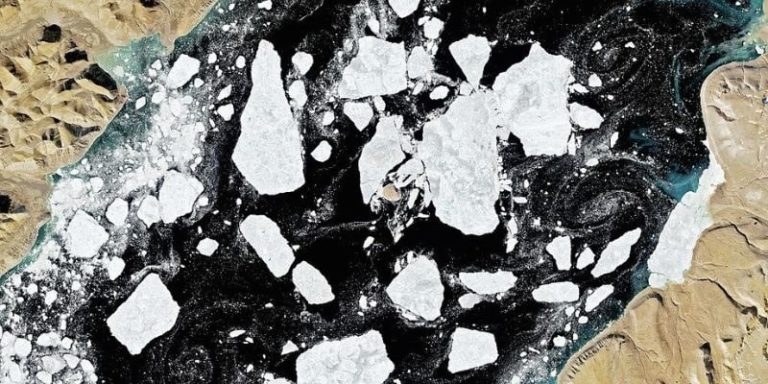Canada and Denmark Make a Deal over Disputed Arctic Island
Tartupaluk, or Hans Island, has been the subject of a 40-year argument over borders.
By: Sarah Cowgill | July 5, 2022 | 570 Words

Hans Island (Photo by USGS/NASA Landsat data/Orbital Horizon/Gallo Images/Getty Images)
Countries don’t always agree on who owns what land, and islands are often the cause of these conflicts. Denmark is a small country in northern Europe, while Canada is located in North America – yet they both had claims on an island in the Arctic. Fortunately, it seems the argument has finally been resolved.
After 40 years, the dispute between Denmark and Canada over who owns an Arctic Sea passageway island has been successfully settled – with no hurt feelings. The island, Tartupaluk, or Hans Island, lies between Greenland and Ellesmere Island.
The island has no people living on it, mineral deposits, or much of anything but animals and sea birds. So, for most of its existence, it was simply a hunting ground for the native Inuit population of Nunavut. Yet a fight popped up between Canada and Denmark in the 1970s over maritime rights.
 Decades later, the two nations have struck a deal. The tiny piece of rock – a half-mile-square in area – will now sport a new border across the island, splitting it between the Canadian territory of Nunavut and the semi-autonomous Danish territory of Greenland.
Decades later, the two nations have struck a deal. The tiny piece of rock – a half-mile-square in area – will now sport a new border across the island, splitting it between the Canadian territory of Nunavut and the semi-autonomous Danish territory of Greenland.
Aluki Kotierk, a native Inuk negotiator, praised the treaty: “The dispute between Canada and Denmark over Tartupaluk or Hans Island has never caused issues for Inuit. Regardless, it is great to see Canada and Denmark taking measures to resolve this boundary dispute.” She also pointed out, “Canada’s sovereignty in the Arctic is only possible because of Inuit use and occupancy.”
Michael Byers is an Arctic expert and political scientist at the University of British Columbia. He explains how tensions popped up again in 1983 as Canada issued a land-use permit to a petroleum company. The idea was to use the island to study how sea ice might affect oil drilling rigs. But, not to be outdone, the Danish Minister of Greenland, Tom Hoyem, hopped into a helicopter quickly and planted a Danish flag.
Non-violent protests and playful competition between both countries erupted over the years. Military forces would leave gifts after visiting the island with note cards saying either “Welcome to Denmark” or “Welcome to Canada.” The conflict became known as the “Whiskey War” because the two sides would leave bottles of alcohol as “presents” for each other.

Tom Hoyem (Photo by Uli Deck/picture alliance via Getty Images)
However, the politicians were not as friendly. The Canadians built an Inuit stone marker in 2005 called an inukshuk. But then Mr. Hoyem wrote an opinion as to why Denmark was still the only valid owner: “Hans Island has been used for centuries by Greenlandic Inuit as an ideal vantage point to get an overview of the ice situation and the hunting prospects, especially for polar bears and seals. The Canadian Inuit have never used the island.”
But all that was resolved when cooler heads prevailed, and equal passage for the two countries seems to be in place – for now. As Professor Byers reminded, the Inuit in Greenland and Nunavut “are the same people, and they did not have boundaries and borders prior to Europeans arriving.” He continued, “You will be able to go to Hans Island and step from Canada into Europe and back into Canada. I can’t imagine there will be any border official there.”
Why can’t we all get along like present-day Denmark and Canada?
















